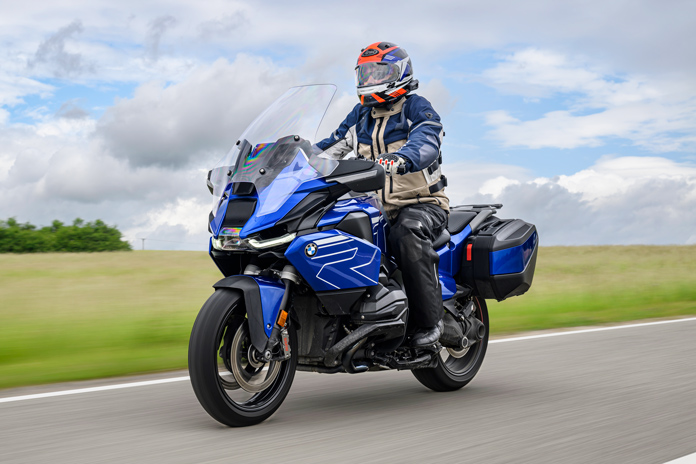
ridermagazine.com
2026 BMW R 1300 RT Review
Nearly five decades after the R 100 RT was introduced, the R 1300 RT stands at the pinnacle of sport-touring. (Photos courtesy BMW)
There’s just something right as rain about riding through the postcard-perfect German countryside on one of BMW’s latest motorcycles. Even if it does actually rain. We were in Germany for BMW Motorrad Boxer Days, a press launch that included technical deep dives and test rides on three new-for-2026 models: the BMW R 12 G/S adventure bike, the BMW R 1300 RT sport-tourer, and the BMW R 1300 R roadster (review coming soon).
R-series boxer-powered motorcycles are the life blood of BMW Motorrad. The first BMW motorcycle, the 1923 R 32, had an opposed flat-Twin (boxer) engine, a longitudinal crankshaft, and shaft final drive. Motorcycles with the same configuration have been in BMW’s lineup for over a century.
Shown with the optional top case.
In the mid to late 1970s, BMW launched several variants of the 980cc R 100 platform: the R 100 S (for Sport, with a small bubble fairing like the one on the iconic R 90 S), the R 100 RS (for Reise, or Travel, Sport, the first production motorcycle with a full fairing), and the R 100 RT (for Reise Tourer, similar to the RS but with an enlarged fairing, Krauser saddlebags, and a heel-toe shifter).
The RT, which evolved into R 1100, R 1150, R 1200, R 1250, and now R 1300 versions, has always been one of BMW’s top-of-the-line touring models. The other has been the liquid-cooled inline 4-cylinder K-series LT (Luxury Tourer) models, which began with the K 100 LT in 1986 and continues today with the K 1600 GTL.
The RT’s more modern, muscular bodywork provides improved weather protection for the rider and passenger.
Rider has tested them all, and three have been selected as Motorcycle of the Year: K 1200 LT in 1999, K 1600 GTL in 2012, and R 1200 RT in 2014.
The point of this walk down history lane? BMW Motorrad takes touring seriously. It has been designing and building tourers with fairings, saddlebags, and other creature comforts for nearly five decades, steadily adding power, refinements, and technological improvements along the way. The R 1250 RT, introduced in 2019, was a fantastic motorcycle that set a high bar in the sport-touring segment. How much better could the BMW R 1300 RT possibly be?
Quite a bit, actually.
New lower cylinder fairings protect the rider’s feet from wind and splashing water.
RT Reset
The BMW R 1300 RT is based on the same platform as the R 1300 GS that was introduced for 2024 and was Rider’s Motorcycle of the Year. It was a clean-sheet machine, a revolutionary redesign rather than just a bump in displacement and a few more bells and whistles. As we wrote in our review of the R 1300 GS, “only the butterfly valves and a few bolts and connectors carry over from the R 1250 GS.”
The RT’s engine is still an air- and liquid-cooled boxer, as it has been for more than a decade, and it retains the vertical-flow cylinder heads, variable oil intake, DOHC valvetrain with light cam followers, and ShiftCam variable valve timing system that were on the 1250.
Dynamic Chassis Adjustment changes steering head angle and ride height from relaxed to sporty.
GEAR UP
Helmet: Arai Contour‑X
Jacket: Rev’It Sand 5
Gloves: Rev’It Sand 5
Pants: Rev’It Sand 5
Boots: BMW
But the similarities end there. The new engine is more compact, weighs 8.3 lb less than its predecessor, and has revised internals. The cams are driven by a new timing chain arrangement, with the right cylinder’s timing chain in front of the cylinder and the left cylinder’s chain behind the cylinder. Cam timing has been revised, the valves are larger, and the compression ratio is higher (13.3:1, up from 12.5:1). A larger 106.5mm bore (up from 102.5) and a new crankshaft with a shortened 73mm stroke (down from 76) boost displacement from 1,254cc to 1,300cc.
Compared to the R 1250, the R 1300 generates more horsepower (145 at 7,750 rpm, up from 136), more torque (110 lb-ft at 6,500 rpm, up from 105 lb-ft at 6,250 rpm), and a broader spread of torque. A new lightweight 2-into-1 stainless steel exhaust system contributes to a 14.3-lb weight reduction for the powertrain.
As with the R 1300 GS, the RT’s former tubular-steel bridge frame and subframe were replaced by a steel sheet metal frame and an aluminum lattice subframe. The new chassis design is stiffer, better centralizes mass, and optimizes load distribution when riding with a passenger or luggage.
The TFT display is impressive, and the redesigned cockpit appears more open from the rider’s point of view.
Renewed Purpose
At first glance, the R 1300 RT’s silhouette is easily recognizable: the large, curved windscreen, the broad fairing, and the integrated mirrors, all designed to protect the rider and passenger from wind and rain. But it carries itself in a new way: slimmer and more muscular, modern, and purposeful.
A touring bike has one job above all else: Make long days in the saddle enjoyable. The RT has long been one of the best motorcycles for burning serious miles, and the R 1300 RT is even better. Not only is its bodywork sleeker and more aerodynamic, but it’s also designed to provide more comfort for the rider. The fairing side panels slide up and down to adjust the amount of air that enters the cockpit, Variable Wind Deflectors are optional, and small cylinder fairings protect the rider’s feet. The removable saddlebags are smaller (capacity is 27 liters each, down from 35) to allow more room for the passenger’s lower legs. If you need more packing space, the optional Variable Luggage System electrically expands or contracts the bags’ width as needed, changing their capacity over a range from 27 to 33 liters.
Design Option Wheels are part of the Impulse Package.
The RT has always looked more imposing when parked than it feels when sitting in the saddle. That’s still true, and the RT is no lightweight – curb weight is 620 lb, up from 615 on the R 1250 RT – but its redesign makes it feel more compact and slender from the cockpit. Perception of size has a lot to do with seat height. To accommodate a wide range of riders, the standard seat is adjustable between 32.3 and 33.3 inches, and its tilt is adjustable. The standard seat can also be swapped for a lower (30.7/31.4 inches) or taller (33.0/33.9 inches) seat.
The ergonomic triangle was revised to position the rider farther forward while retaining the same distance between the seat and pegs. The handlebar is farther forward, wider, and less swept back, which puts the rider in a more active stance without sacrificing comfort. Putting more of the rider’s weight toward the front wheel improves handling and opens up more space for the passenger.
The RT gained a few pounds, but it looks and feels lighter from the saddle.
The Telelever EVO front and Paralever EVO rear suspension systems that debuted on the GS are also used on the RT, though with less wheel travel (5.9/6.2 inches vs. 7.5/7.9 inches on the GS). Semi-active Dynamic Electronic Suspension Adjustment is standard and adjusts damping, spring rate, and load automatically as conditions require. Dynamic Chassis Adjustment is a new feature that’s included with optional Ride Modes Pro. In the standard modes – Road, Rain, and Eco – DCA uses a flat steering head angle and lower ride height to maximize stability and comfort. In the Dynamic and Dynamic Pro ride modes, DCA uses firmer damping, a higher spring rate, and a higher ride height, raising the rear more than the front to shorten rake and trail for quicker steering and increased cornering clearance.
Autobahn and Beyond
Out on the road, the larger 1300 feels stronger everywhere. Whether overtaking slow-moving trucks on backroads or merging onto the autobahn, the bike responds effortlessly. The midrange punch makes passing especially easy and pulls strong to the 9,000-rpm redline.
The fairing side panels move up and down to adjust the amount of air that flows into the cockpit.
The R 1300 RT handles like a much lighter motorcycle thanks to the low center of gravity of its boxer with the gearbox mounted below the engine and new wheels that are 3 lb lighter than their predecessors. The new seating position suited my 5-foot-7 frame perfectly, and the redesigned fairing and electrically adjustable windscreen created a small nest of calm air on the highway. Even after hours on the autobahn and unfamiliar twisting backroads, I never felt stressed or uncomfortable.
Our test bikes were equipped with the optional Automated Shift Assistant, which eliminates the clutch lever but retains the foot shifter and offers fully automatic or manual shifting, with automatic shift points adjusted based on ride mode. ASA is not as seamless as it should be. It can feel clunky at low speeds, and although auto shifts are smooth, their timing isn’t always ideal.
The black knob at top left actuates the Variable Luggage System.
More tech abounds on the RT, though its availability depends on which options packages you buy. In addition to ASA ($935), our bikes had the Impulse Package ($7,345), which includes Ride Modes Pro, DCA, the Variable Luggage System, the adaptive Headlight Pro, radar-enabled Riding Assistant (Active Cruise Control, Front Collison Warning, and Lane Change Warning), central locking, and many more comfort and style add-ons. The RT also has a 10.25-inch TFT display offering split-screen navigation, media controls, and phone integration through BMW’s Connectivity Hub, and atop the tank is a vented storage compartment for charging a smartphone.
Touring through Germany presented a variety of microclimates and conditions, and the BMW R 1300 RT took them all in stride. Wind and weather protection were excellent, and the bike felt sure-footed and confident on wet roads – all traits we’ve come to expect from the RT.
Across town to the coffee shop or across the continent, the R 1300 RT will take you there in style and comfort.
The R 1300 RT isn’t just an update of an already-excellent touring motorcycle; it has evolved into a machine that is more than the sum of its parts. Carving along dark forest roads, gliding down the autobahn, or exploring hidden villages, it delivered all the comfort, enjoyment, and power I could ask for. The R 1250 RT was a favorite of ours and that of many sport-touring riders, and the 1300 RT takes things to the next level. It’s more refined, more capable, and more engaging – a bike that makes you want to ride farther just to see what’s around the next bend.
From city centers to scenic mountain passes, the R 1300 RT reminds us that great bikes don’t just take you places – they make the ride itself unforgettable.
2026 BMW R 1300 RT Specs
Base Price: $22,495
Price as Tested: $31,525 (Impulse Package w/ Top Case Prep, Automated Shift Assistant)
Website: BMWMotorcycles.com
Warranty: 3 yrs., 36,000 miles
Engine Type: Liquid‑cooled longitudinal opposed‑Twin, DOHC, 4 valves per cyl.
Displacement: 1,300cc
Bore x Stroke: 106.5 x 73.0mm
Horsepower: 145 @ 7,750 rpm (factory claim)
Torque: 110 lb‑ft @ 6,500 rpm (factory claim)
Transmission: 6‑speed, hydraulically actuated slip/assist wet clutch
Final Drive: Shaft
Wheelbase: 59.0 in.
Rake/Trail: 26 degrees/4.5 in.
Seat Height: 30.7‑33.9 in. (low/standard/tall seats)
Wet Weight: 620 lb (factory claim)
Fuel Capacity: 6.3 gal.
The post 2026 BMW R 1300 RT Review appeared first on Rider Magazine.










